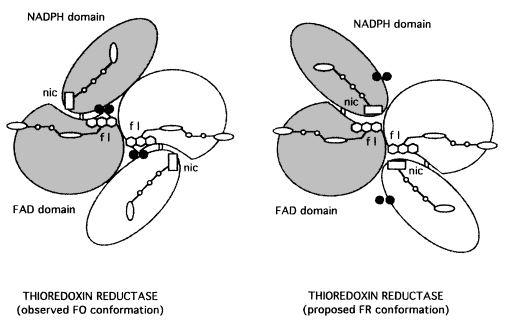User:Luize Nóbrega e Silva/Sandbox 1
From Proteopedia
(Difference between revisions)
| Line 1: | Line 1: | ||
| - | == Introduction: Thioredoxin system == | + | <scene name='91/914431/Active_site/1'>Text To Be Displayed</scene>== Introduction: Thioredoxin system == |
<StructureSection load='1CL0' size='340' side='right' caption='Caption for this structure' scene=''> | <StructureSection load='1CL0' size='340' side='right' caption='Caption for this structure' scene=''> | ||
The <scene name='91/914431/1cl0_color/2'>thioredoxin reductase</scene> of E. coli is a member of the flavoenzymes, responsible for catalyzing the reduction of the redox protein thioredoxin, by using NADPH. <ref>PMID:7557016</ref> The <scene name='91/914431/1f6m/3'>Trx System</scene> has its role as a protein disulfide reductase comprising thioredoxin reductase (TrxR), thioredoxin (Trx) and NADPH. Thioredoxin is the main disulfide reductase responsible for keeping intracellular proteins reduced. The redox reactions are catalyzed by thioredoxin reductase (TrxR) by taking electrons from NADPH and transferring them to the FAD domain of the oxidized Trx (Trs-S2). Electrons are then transferred to the redox active disulfide in the N-terminal of one subunit of TrxR, finally to the C-terminal active site of the other subunit, generating a a dithiol in reduced thioredoxin, Trx-(SH)2. <ref>PMID:20494123</ref> <ref>PMID:11012661</ref> | The <scene name='91/914431/1cl0_color/2'>thioredoxin reductase</scene> of E. coli is a member of the flavoenzymes, responsible for catalyzing the reduction of the redox protein thioredoxin, by using NADPH. <ref>PMID:7557016</ref> The <scene name='91/914431/1f6m/3'>Trx System</scene> has its role as a protein disulfide reductase comprising thioredoxin reductase (TrxR), thioredoxin (Trx) and NADPH. Thioredoxin is the main disulfide reductase responsible for keeping intracellular proteins reduced. The redox reactions are catalyzed by thioredoxin reductase (TrxR) by taking electrons from NADPH and transferring them to the FAD domain of the oxidized Trx (Trs-S2). Electrons are then transferred to the redox active disulfide in the N-terminal of one subunit of TrxR, finally to the C-terminal active site of the other subunit, generating a a dithiol in reduced thioredoxin, Trx-(SH)2. <ref>PMID:20494123</ref> <ref>PMID:11012661</ref> | ||
| Line 6: | Line 6: | ||
== Structure == | == Structure == | ||
The enzyme thioredoxin reductase from Escherichia coli is a homodimer, in which each monomer contains one FAD and one redox active disulfide. The first part of the FAD binding domain (FAD-i), the NADPH binding domain, and the last part of the FAD binding domain (FAD-2) is formed by the polypeptide chain of each monomer. The connection between FAD and NADPH domains is a two-stranded, antiparallel B-sheet, and each one has a secondary and tertiary structure. <ref>PMID:7557016</ref> | The enzyme thioredoxin reductase from Escherichia coli is a homodimer, in which each monomer contains one FAD and one redox active disulfide. The first part of the FAD binding domain (FAD-i), the NADPH binding domain, and the last part of the FAD binding domain (FAD-2) is formed by the polypeptide chain of each monomer. The connection between FAD and NADPH domains is a two-stranded, antiparallel B-sheet, and each one has a secondary and tertiary structure. <ref>PMID:7557016</ref> | ||
| - | The redox active disulfide is formed by Cys135 and Cys138, located in the NADPH domain, adjacent to the re side of the flavin ring and interposed between the flavin | + | The redox <scene name='91/914431/Active_site/1'>active disulfide</scene> is formed by Cys135 and Cys138, located in the NADPH domain, adjacent to the re side of the flavin ring and interposed between the flavin |
and NADPH binding site. <ref>PMID:7557016</ref> This structure conformation blocks the path of electrons from reduced pyridine nucleotide to the substrate disulfide via the isoalloxazine ring and the redox active disulfide, as it happens in the other member of this enzyme family. That distinction of the NADPH binding site from the flavin happened because of the juxtaposition of the FAD binding and NADPH binding domains, and it can be explained by conformational changes thioredoxin reductase suffer to enable the path of electrons in the catalyze. <ref>PMID:10947986</ref> | and NADPH binding site. <ref>PMID:7557016</ref> This structure conformation blocks the path of electrons from reduced pyridine nucleotide to the substrate disulfide via the isoalloxazine ring and the redox active disulfide, as it happens in the other member of this enzyme family. That distinction of the NADPH binding site from the flavin happened because of the juxtaposition of the FAD binding and NADPH binding domains, and it can be explained by conformational changes thioredoxin reductase suffer to enable the path of electrons in the catalyze. <ref>PMID:10947986</ref> | ||
Revision as of 21:22, 19 June 2022
== Introduction: Thioredoxin system ==
| |||||||||||


